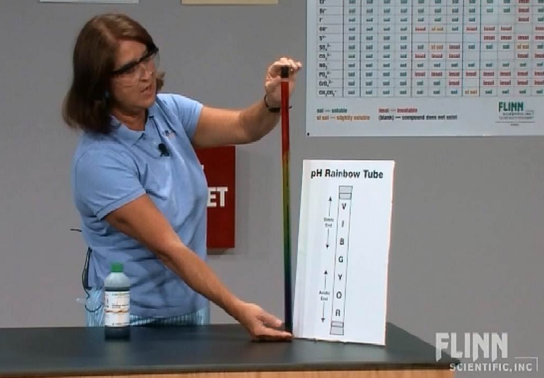Introduction
In this demo, the teacher creates a beautiful rainbow of colours in a demonstration tube using universal indicator and a dilute
acid and base.
Discussion
Universal indicator can be used to illustrate an entire range of pH conditions because it is made up of a mixture of different
indicators that change colour at different pH values. As an acid is diluted with water, its pH increases—but never above pH 7.
Likewise, as a base is diluted, its pH decreases—but, again, never below pH 7.
The half-colour spectrum that you see after adding just the hydrochloric acid solution and inverting the tube is comparable to what one would see after performing a series dilution of hydrochloric acid. Although the hydrochloric acid solution concentration may range from 10–1 M at the bottom of the tube to 10–13 M at the top of the tube, the corresponding pH values will be approximately 1, 2, 3, 4, 5, 6, 7, 7, 7, 7. . . . It is the 1 × 10–7 M H3O+ already present in the water that is ultimately responsible for the pH reaching this plateau of 7 and for the colour not changing beyond the neutral (green) point. This is important to
point out to students who might think that they can use the log of the hydrochloric acid solution concentration, no matter how dilute, to derive the pH of the solution. Certainly you can never add hydrochloric acid solution to neutral water and expect to get a pH greater than 7! Likewise, you cannot expect dilute base solutions to have pH values of less than 7. Therefore, to derive the entire pH scale by series dilutions, you must use both an acid and a base—starting, of course, at opposite ends. This is exactly what is accomplished in the pH rainbow tube.
Click here to download the complete instructions
Website: https://www.flinnsci.ca/
Facebook: https://www.facebook.com/flinnscientificcanada


